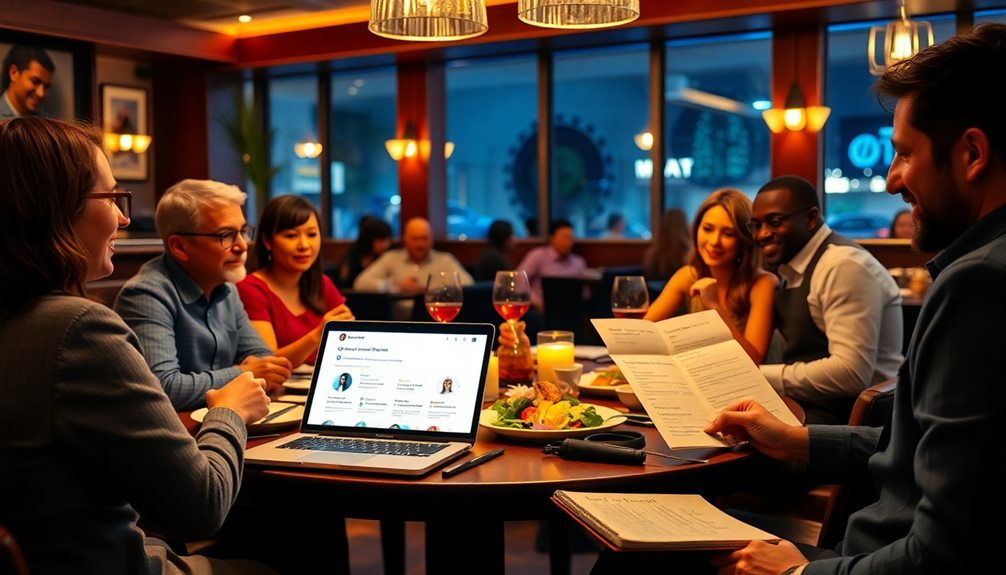To train restaurant servers effectively, start by creating a thorough training manual that outlines your mission, dress code, and service guidelines. Conduct orientation sessions to align new hires with your values, followed by hands-on shadowing with experienced servers. Incorporate menu tastings to boost their confidence and encourage upselling. Use roleplay exercises to prepare them for customer interactions and complaint management. Remember to implement a system for continuous feedback with regular check-ins to support their growth. With the right approach, your team will thrive and enhance the overall dining experience, leading to greater success for your restaurant. There's more to explore on this topic!
Key Takeaways
- Develop a comprehensive server training manual that includes mission statements, dress code, and service guidelines for clear expectations.
- Conduct orientation sessions to align new hires with the restaurant's values and offerings, ensuring a strong foundation.
- Implement hands-on training through shadowing experienced servers, allowing new hires to learn effective service techniques in real-time.
- Regularly conduct menu tastings to enhance servers' knowledge and confidence in discussing dishes with customers.
- Establish a structured feedback mechanism with regular check-ins to track performance and promote continuous improvement.
Importance of Server Training
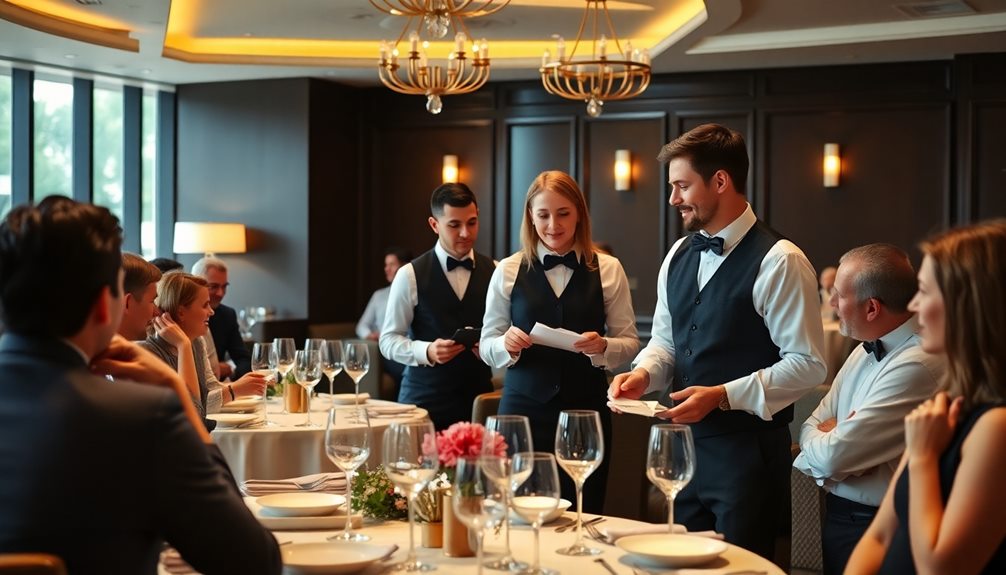
Server training isn't just a checkbox on your restaurant's to-do list; it's a fundamental element that shapes the success of your establishment. Effective server training is crucial in reducing staff turnover, fostering employee satisfaction, and creating a motivated team.
In an industry plagued by a high turnover rate, investing in your staff's development pays off. Well-trained servers greatly enhance the guest experience, elevating your restaurant's reputation and driving customer loyalty.
It's clear that many restaurants are missing the mark. While approximately 68% share an employee handbook, only 19% utilize online training.
This gap highlights the need for structured training programs that not only prepare your staff for daily tasks but also provide ongoing support. Regular check-ins can guarantee your servers adapt to evolving guest expectations, especially as dining preferences shift post-COVID-19.
Structured Training Approach
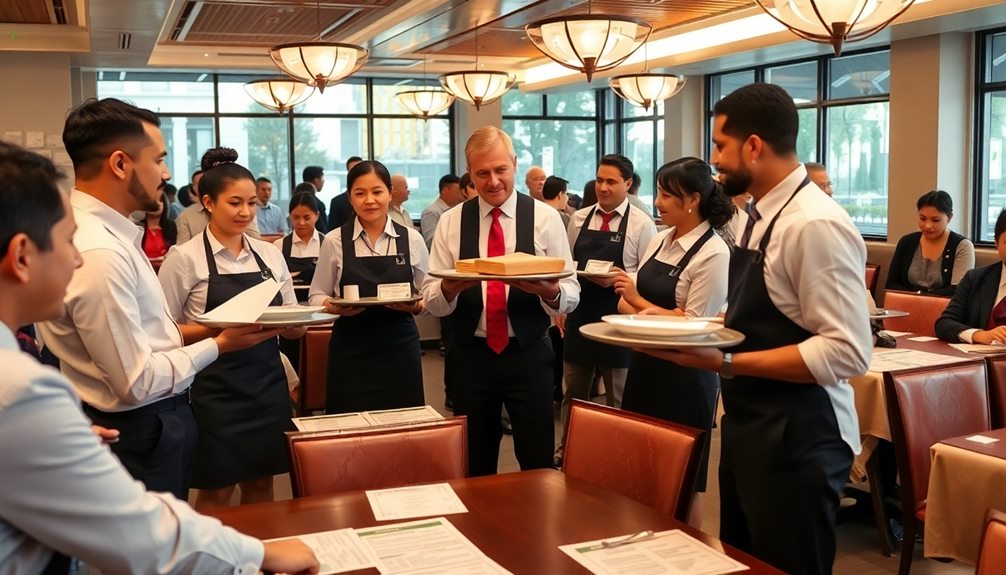
A structured training approach is vital for creating a consistent and effective onboarding experience for new hires. Begin by developing a thorough server training manual that outlines your restaurant's mission, dress code, service guidelines, and etiquette standards. This manual helps guarantee clarity for everyone involved.
Hold detailed training sessions featuring an orientation that aligns new employees with your restaurant's values and expectations. Foster a welcoming atmosphere through team introductions and Q&A sessions.
Hands-on learning is essential, so have new hires shadow experienced servers. This allows them to observe best practices, locate supplies, and understand opening and closing procedures in real time.
Incorporate menu tastings into your training to enhance servers' familiarity with dishes and improve their ability to answer customer inquiries effectively. This also supports upselling techniques.
Finally, implement roleplay exercises to prepare new servers for real-life situations. Simulating customer interactions, handling complaints, and managing multiple tables will build their confidence and competence in customer service.
Hands-On Experience
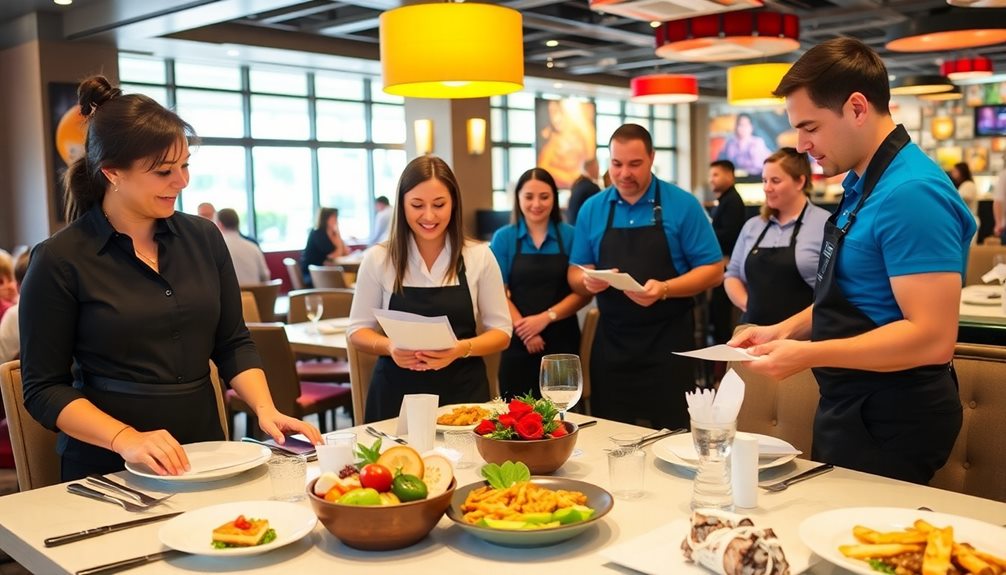
Gaining hands-on experience is crucial for new restaurant servers to build confidence and competence in their roles. By immersing yourself in practical situations, you can quickly grasp the nuances of effective service.
Here are key aspects to focus on during your training:
- Shadowing: Observe experienced servers to learn effective service techniques and customer engagement.
- Hands-on training with the POS system: Familiarize yourself with entering orders and processing payments, which is essential during busy service periods.
- Order-taking practice: Work with trainers to reinforce menu knowledge and guarantee accurate communication of customer requests.
- Understanding sidework duties: Get to know the storage locations for important items to enhance service efficiency.
- Observing service strategies: Learn appropriate pacing and multitasking to manage multiple tables effectively.
These hands-on experiences won't only improve your skills but also prepare you for the fast-paced environment of a restaurant.
Embrace each opportunity to practice, and you'll find yourself becoming a more confident and competent server in no time.
Menu Knowledge Development
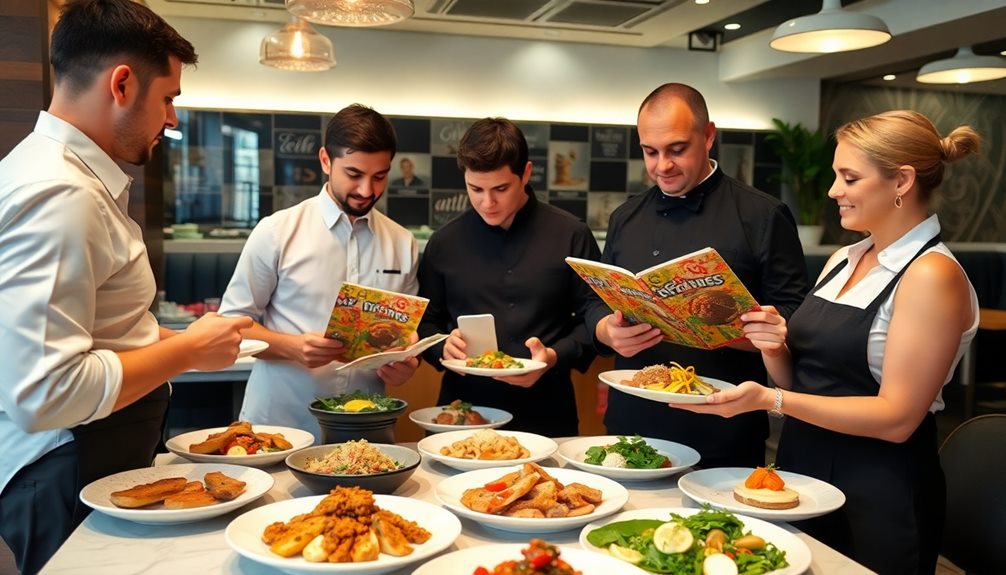
Hands-on experience lays the groundwork for developing extensive menu knowledge, which is crucial for successful service. To guarantee your servers excel, incorporate a structured training program that includes a thorough training manual. This should cover all menu items, including daily specials and extensive wine selections.
Start new employees off with a detailed orientation session, focusing on the restaurant's offerings and food safety protocols. Regular menu tastings are essential; they allow servers to taste new and popular dishes, boosting their confidence when engaging with customers.
Studies show that servers who can recite specials from memory can increase sales by up to 20%, so encourage memorization of menu items. Make it a point to update your team on any menu changes or seasonal items. Since 68% of guests value accurate information about the latest offerings, your servers should feel prepared to provide this insight.
Lastly, foster an environment where learning is ongoing. Encouraging questions and discussions about menu knowledge helps enhance customer experiences and builds a knowledgeable team. With solid training and support, your servers will become invaluable assets to your restaurant.
Continuous Feedback and Support

Feedback loops are essential in nurturing your servers' skills and confidence. By implementing continuous feedback, you promote server development and performance improvement throughout their training period.
Establishing a structured feedback mechanism, with check-ins at 30, 60, and 90 days, guarantees that servers feel supported and can track their growth.
Consider these strategies to enhance your feedback process:
- Hold regular one-on-one meetings to discuss performance and improvement areas.
- Use guest feedback from POS systems or feedback cards for real-time insights.
- Encourage peer support among servers to foster collaboration and constructive feedback.
- Reinforce consistency in service through regular evaluations, enhancing service quality.
- Monitor team performance to identify best practices and areas needing attention.
Frequently Asked Questions
How Do Restaurants Train Servers?
Restaurants train servers through structured orientations, shadowing experienced staff, conducting menu tastings, and practicing role-playing scenarios. They provide ongoing feedback and conduct evaluations at set intervals to guarantee you're confident and ready for independent service.
How to Train a New Waitress?
To train a new waitress, you'll start with a thorough orientation on policies, engage her in hands-on shadowing, conduct menu tastings, practice through role-playing, and schedule regular check-ins to support her progress.
Which Type of Training Is Most Important for a Restaurant Server?
When considering the most important training for a restaurant server, focus on product knowledge. It enhances customer experience, builds trust, and boosts upselling potential, ultimately leading to higher satisfaction and increased profitability for your establishment.
How to Train Restaurant Employees Effectively?
To train restaurant employees effectively, you should create a clear manual, conduct engaging orientations, allow shadowing with experienced staff, hold regular tastings, and use roleplay to simulate real customer scenarios. This boosts confidence and skills.
Conclusion
Training your restaurant servers isn't just a task; it's an investment in your business's success. You might worry that it takes too much time, but remember, well-trained servers create memorable experiences for your guests, leading to repeat visits and positive reviews. When your team feels confident and equipped, they'll deliver exceptional service that keeps customers coming back. Embrace this journey—you're not just training staff; you're building a passionate team that shares your vision for success.



